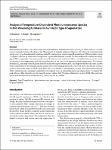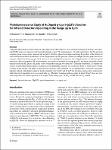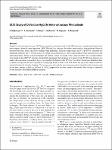Search
Author
- Kopytko, M. (2)
- Majkowycz, K. (2)
- Manyk, T. (2)
Subject
- MOCVD (2)
- DLTS (1)
- InAsSb Type-II Superla... (1)
- LWIR (1)
- next >
Date issued
- 2023 (3)
Has File(s)
- true (3)
Search Results
Photoluminescence (PL) is one of the commonly used methods to determine the energy gap (Eg
) of semiconductors. In order to use it correctly, however, the shape of the PL peak must be properly analyzed; otherwise, the value of Eg
is burdened with a large error. Eg
is often mistakenly attributed to the PL peak position, which in type-II superlattices (T2SLs) exhibits typical “S-shaped” behavior as a function of temperature, significantly different from the Varshni model used to define the energy gap of III-V compounds. The position peak of the PL relative to the real Eg
in T2SLs is red-shifted because of the carrier localization at low temperatures and blue-shifted because of the free carrier emission at high temperatures. To correctly determine Eg
, the shape of the PL peak ... |
A HgCdTe photodiode grown by chemical vapor deposition (MOCVD) on a GaAs substrate operating in the long-wave infrared (LWIR) range was characterized using photoluminescence (PL) measurements. At high temperatures, the PL spectrum originates from a free-carrier emission and might be fitted by a theoretical expression being the product of the density of states and the Fermi–Dirac distribution. At low temperatures, the PL spectrum consists of multiple emission peaks that do not originate solely from the energy gap. Such spectra are not unambiguous to interpret due to the prominence of different optical transitions. Spectral response (SR) measurements were used to determine the energy gap (Eg) and extract the band-to-band transition from the PL spectra. PL peaks visible within the band... |
Deep-level transient spectroscopy (DLTS) measurements were performed on HgCdTe heterostructure photodiode grown by metal-organic chemical vapor deposition (MOCVD) on GaAs substrate. In order to extract defects from individual layers of the heterostructure, three consecutive etchings were performed. In the first experiment, the N+/T/p/T/P+/n+ structure was chemically etched to the N+ bottom contact to obtain a mesa-type detector. Six localized defects were extracted across the entire photodiode. In the second experiment, the bottom contact was made to the p-type absorber. Two localized defects were found in the p/T/P+/n+ structure. |



